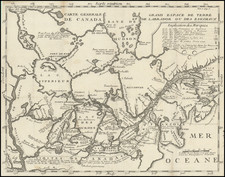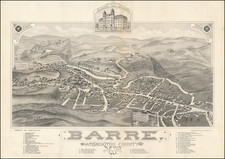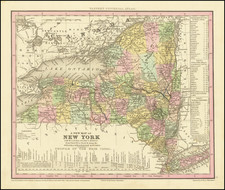Mapping The Hudson Valley Route, Up River to Lake George & Lake Champlain from New York City to Canada
This rare Revolutionary War Era map was created by the French cartographer Claude Joseph Sauthier and engraved by William Faden, Geographer to the King, in October 1776. This comprehensive map, meticulously illustrating the Hudson River and its adjacent regions from New York Bay to Fort Edward, also details the communication routes with Canada via Lake George and Lake Champlain.
The publication of this map coincides with the tense atmosphere of the Revolutionary War period, and it emphasizes the strategic significance of the Hudson River-Lake George-Lake Champlain corridor. The British saw this artery as an essential invasion route between Canada and the Middle British Colonies of North America, a view underscored by the map's careful detailing of the region.
Sauthier's map is divided into three vertical panels, each providing a unique topographical perspective. The left panel portrays New York City and Harbor in precise detail and proceeds up the river to Rhinebeck. The center panel, encompassing the intersection with the Mohawk River and Lake George, stretches north to Ticonderoga. The right panel, meanwhile, covers Lake Champlain.
Uniquely, the map represents the primary water courses with immense precision, extending from depth soundings as far north as Albany and identifying navigational hazards on Lake Champlain. Essential military information, such as the locations of major roads and forts, as well as details of portages, appear meticulously captured. It also records key military events, such as the naval battle on Lake Champlain in October 1776, involving Benedict Arnold, and a skirmish from the French & Indian War resulting in the French scuttling their "fleet" in 1759.
Claude Joseph Sauthier, a French native, began his work in the colonies in 1767, under the employ of Governor Tryon of North Carolina. He later moved to New York with Tryon and engaged in significant surveying work in the eastern part of the province, including running the boundary line between New York and Quebec at the 45th parallel. This map offers a unique amalgamation of his expertise in cartography and his firsthand experience of the North American landscape during a transformative historical period.
State
Stevens & Tree's 3rd of 4 states, without the extra note to the east of Lake Champlain.









![[ French & Indian War Battle Plan--Louisbourg ]. Plan De Louisbourg...](https://storage.googleapis.com/raremaps/img/small/57192.jpg)

![Partie du Cours du Fleuve de Saint Laurent depuis Quebec jusqu'au Cap aux Oyes [on sheet with] Carte du Cours du Fleuve Saint Laurent depuis Quebec jusqu'a la Mer en Deux Feuilles ... 1761](https://storage.googleapis.com/raremaps/img/small/55185.jpg)


